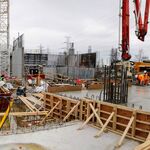abovetoronto
New Member
Movement on the Confederation GO station:
RQQ-2020-PROC-479 - RQQ-2020-PROC-479: Procurement Service Provider for Construction Management Gene
RQQ-2020-PROC-479 - RQQ-2020-PROC-479: Procurement Service Provider for Construction Management Gene
Tender No. RQQ-2020-PROC-479
Metrolinx is issuing this Request to Qualify and Quote (RQQ) to retain the services of Vendor to provide the goods and/or services described herein. Metrolinx intends to notify a Proponent of acceptance of its Submission and enter into a Contract through an open, fair and competitive process.
Metrolinx is accepting Submissions for the Procurement Service Provider for Construction Management General Contractor (CMGC) Procurement Model as more particularly described in this Request Document as required by Metrolinx.
Metrolinx is a crown agency of the Government of Ontario under the Metrolinx Act, 2006, reporting to the Ministry of Transportation. It was created to improve the coordination and integration of all modes of transportation in the Greater Toronto and Hamilton Area (GTHA). The Metrolinx mandate includes delivering the best possible transportation services today while leading the way to an even better, more convenient service tomorrow; making the best possible use of public transportation investment dollars; and measurably improving the quality of life in the region.
In September 2018, Metrolinx’s Sponsors Office prepared a business case to appraise the business need for Confederation GO Station based on estimated construction costs and the latest ridership demand projections. It determined that the Full LEED Gold Station building, as originally designed, would not be required to serve the demand of the Centennial Parkway area of Hamilton. Following discussions with the Project Delivery team, Stakeholders, and Sponsors Office, it was agreed to de-scope the work and to redesign Confederation GO Station to suit current needs and projected demand.
All construction scope to the south parking area, has been eliminated. Due to the removal of these works, a retaining wall will be constructed following the south property line to support the future Track 4. Tracks 1 & 2 will be relocated by CN prior to construction, and future Tracks 3 and 4 will be installed by CN following construction, as previously planned.
The platform canopy has been reduced to extend from the mini-platform to Centennial Parkway Rail Bridge and to additional stand-alone shelters on the west end of platform. The rail platform, canopy and structure have been designed to be compatible with future level boarding design.
This project also includes infrastructure improvements undertaken by CN, which include the supply and installation of four through plate girders (TPG) spans, fibre-optic cable relocation, related corridor grading and track shifts to accommodate a future four track corridor for two CN tracks and two GO tracks. A new retaining wall on the south ROW will protect the embankment for the future track construction. All work on the south side parking lot has been de-scoped and will be considered for future expansion.
The objective of this Request to Qualify and Quote (RQQ) is to solicit proposals from Proponents for the provision of services in providing expertise and lead a Construction Management General Contractor complex procurement over a one (1) year term with the option of one (1) extra year at the end of the first year.
The requirements are more particularly described in Scope of Work of this Request Document.
ELECTRONIC BID SUBMISSION will be accepted until 3:00 p.m. on November 30,2020.







